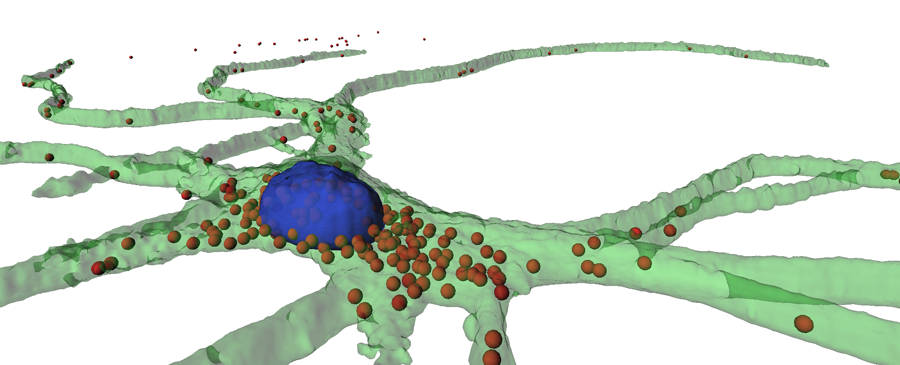Protein synthesis at synapses
May 16, 2012
Max Planck Institute (MPI) for Brain Research researchers have used new-generation sequencing to directly identify a very large number (more than 2500) of mRNA molecules present in axons and dendrites. The finding my help explain how proteins establish long-term memories.
During learning, information is stored at the synapses, the junctions connecting nerve cells. Synapses also require new proteins to show changes in their strength (synaptic plasticity). Historically, scientists have focused on the neuron cell body as the place where the required proteins are synthesized.
However, in recent years there has been increasing focus on the dendrites and axons (the compartments that meet to form synapses) as a potential site for protein synthesis. Protein synthesis machines have been observed there, as well as a limited number of their templates, the messenger RNA (mRNA) molecules.
However., the limited number of mRNAs observed in dendrites and axons placed constraints on the constellation of proteins that could be synthesized to help synapses work and change. Using microarray approaches and in situ hybridization techniques, many different research groups had each identified a hundred or so mRNAs that might reside in the dendrites.
By comparing these studies, the Schuman team discovered something surprising: not a single mRNA type was found in all three studies. This observation made the scientists at the MPI for Brain Research wonder whether the already discovered mRNAs are just the tip of the iceberg and whether there were many more mRNA molecules waiting to be discovered.
To find out, the researchers dissected the neuropil layer of the rat hippocampus. This layer comprises a high concentration of axons and dendrites, but lacks the cell bodies of pyramidal neurons (the principal cell type in the hippocampus and other brain areas). By using sensitive high-resolution sequencing techniques, mRNAs could be detected which, due to their lower concentrations, were not discovered before.
The researchers found an impressive number of 2550 unique mRNAs present at the dendrites and/or axons. To determine the relative abundance in the neuronal cells, the scientists at Erin Schuman’s lab used the Nanostring nCounter, a new technique allowing for high-resolution visualization and quantification of single mRNA molecules. They found that the concentration of mRNAs in the neuronal cells varies by three orders of magnitude.
Additionally, the researchers were able to classify many of the mRNAs and determine their function in synaptic plasticity. These include signalling molecules, scaffolds and the receptors for neurotransmitter molecules. In addition, many mRNAs coding for protein implicated in diseases like autism were discovered in the dendrites and axons. Finally, by using advanced imaging techniques, the researchers could directly visualize some of the mRNAs in the neuronal dendrites, hundreds of microns (millionths of meter) from the cell body.
These results reveal a previously unappreciated enormous potential for the local protein synthesis machinery to supply, maintain and modify the dendritic and synaptic protein population. It seems that neurons use a local control mechanism much in the same way that modern societies have learned that the most efficient means to distribute goods to the population is to use local distribution centers.
Ref.: Iván J. Cajigas et al., The Local Transcriptome in the Synaptic Neuropil Revealed by Deep Sequencing and High- Resolution Imaging, Neuron, 2012, DOI: 10.1016/j.neuron.2012.02.036
